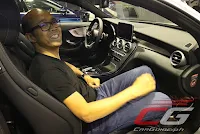“Their designs were going down in quality,” recalls Winifredo Camacho when he first entered Mercedes-Benz some 20 years ago. “Designers were overworked and it showed.” A result of the German luxury automaker’s aggressive product expansion plans then, Wini, as his friends call him, had his work cut out. He remembered how from just the three basic model ranges (C-, E-, and S-Class), Mercedes-Benz designers suddenly had to design double the number of model ranges. It necessitated a top-down rethink; one that Wini’s an integral part of.
Today, Wini works as the Senior Exterior Designer for Mercedes-Benz. Based in Singelfingen, Germany, Wini focuses his efforts on, as his title suggests, the exterior design. As Mercedes-Benz’s product range grew to 13 models (not even counting the dedicated AMG cars), the company quickly realized that in order to achieve their “Best or Nothing” brand ethos, they had to rethink their design process. By making their designers specialize in a car’s particular aspect, they could give it their full attention.
“We have designers who do just the exterior or the interiors. We even have designers who do nothing but create the intricate elements you see in the lights or wheels,” says Wini. “By rethinking how Mercedes-Benz approaches design, they have never been more beautiful. Without bias, the current lineup is the most beautiful they’ve ever been in the past two decades.”
Of course, that’s not to say there’s going to be any sort of disconnect between a car’s different elements. Under the leadership of Gorden Wagener, Head of Design for Daimler AG, Mercedes-Benz approaches design with a holistic mindset. With a unified design code with six pillars (Unexpected Moments, Stimulating Contrast, Stunning Proportions, Freeform & Geometry, Significant Graphics, and Natural Attraction), each model range interprets it differently ensuring a unique character, while remaining recognizable as a Mercedes-Benz. By making every touchpoint experiential, it elevated not just the cars, but the brand into a luxury label.
Dubbed Sensual Purity, Mr. Wagener declared that the days of creases are over. Instead of modifying a basic shape with lines, this design philosophy employs sweeping surfaces at angles to each other, effectively contouring the body using light and shadow. It sounds seemingly contradictory as well, yet it’s a term that Mercedes-Benz uses to express luxury: modern yet timeless; emotive yet rationale; genuine yet technical. It’s also representative of the two men at the core of Mercedes-Benz: Gottlieb Wilhelm Daimler and Carl Friedrich Benz.
Indeed, looking around the Mercedes-Benz showroom shows that the Sensual Purity form is present in the automaker’s entire lineup from small hatchbacks to sports cars to full-sized vans. Wini’s personal favorite though, he reveals, is the C-Class Coupe.
Moving on, Wini revealed that the one model that challenged him as a designer isn’t available locally yet: the X-Class. Designing the carmaker’s first pickup truck was like sailing into uncharted waters, but it’s one ship that he commanded well.
Though the design of the production model fell to a different group, Wini and his team was tasked to design the Concept X-Class show cars. With the world’s spotlight on him, he rose to the challenge and designed not just one, but two interpretations of a true premium pickup truck.
The Concept X-Class, and by its extension, the production X-Class, is a response to changing consumer demographics. Pickup trucks weren’t just workhorses anymore. They were both lifestyle and business vehicles with customers demanding comforts of a passenger vehicle with all the versatility expected of a pickup truck. It’s a trend Mercedes-Benz realized some 20 years ago with their first SUV: the M-Class.
“The challenge of designing the Concept X-Class didn’t lie in that it shared an architecture with other brands [Nissan NP300 and Renault Alaskan]. The bigger challenge was how to give it the Sensual Purity form given that a pickup truck’s form is so defined. In the end, I’m proud of what we accomplished in so little time [8 months]. Mr. Wagener particularly liked the treatment of the rear with its continuous LED light strip in a slim chrome surround on the tailgate. It’s certainly something we’d like to see in a future design.”
And speaking about the future, Wini says that tougher safety regulations and more stringent fuel economy standards has had its effect on design already.
“In my line of work, I’m usually given a free hand. The board gives me a design brief—like what particular segment this vehicle caters to, what’s the size, and the like. During the course of the design phase, we sometimes argue with engineers to preserve a design element or two for improved safety, packaging, or aerodynamics. Sometimes we win, sometimes we come up with a clever solution. It’s all part of the design challenge,” says Wini as he showed the different intricacies of Mercedes-Benz design from the A-Class’s rear spoiler to the E-Class’s taillights.
Posing an even bigger challenge is how new technologies such as Electric Vehicles and Autonomous Driving will affect a car’s design. In fact, there are some who predict that a car may be commoditized like a household appliance. Not so according to Wini.
“Design will always be an integral part of a car. The way it’s packaged or even the way it drives may change, but good design is always the first thing that draws your attention to it. It’s the first thing that makes you say: I want it. More than that, great design is much more than simply creating beautiful products. It should combine functionality with fascination. It ultimately also gives the brand a distinctive form.”










No comments:
Post a Comment
Feel free to comment or share your views. Comments that are derogatory and/or spam will not be tolerated. We reserve the right to moderate and/or remove comments.